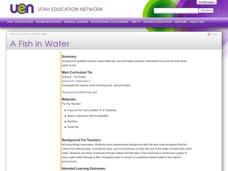Curated OER
Mountain Building
Fourth graders identify variables that influence rates of change. They, through group consensus and using the assigned materials, design and build what they believe to be the strongest mountain possible.
Curated OER
Plotting the Petroleum Plume
Eighth graders examine the difference between confining layers and aquifers in a basic water table aquifer scenario. They contour groundwater elevation and petroleum product thickness data.
Curated OER
Materials Engineering: Designing Walls
Students discover how the matierals in the earth can be used to make walls and buildings. They examine the Great Wall of China and its engineering. They complete the unit by creating their own wall from a design they drew.
Curated OER
Go With the Flow
Students experiment with a simulated river bed and examine how erosion takes place faster with a young, fast-moving river than with a slow, older river.
Curated OER
Turn On A Light And Do Your Own Revegetation
Students use electricity and plant a seed to observe the process when coal is the major fuel source to produce electricity. They use the packet of native seeds to experiment with revegetation.
Curated OER
Habitat Unit - Day 2
Students explore abiotic factors that affect habitats. After a class lecture, students work in groups to answer questions about plant tissue, production and growth. They share answers, complete a crossword puzzle, and create a habitat...
Curated OER
Exploring For Copper Deposits
Students examine ore deposits and identify factors in their origin. They analyze geologic maps, and locate porphyry copper deposits on a sediment geochemistry map.
Curated OER
Limestone
In this limestone activity, students name three sources of calcium carbonate, write the chemical formula, and determine the three elements found in calcium carbonate. This activity has 7 short answer and 3 problems to solve.
Curated OER
Leave What You Find
Students explore environmental awareness by participating in a role play activity. In this cultural analysis lesson, students discuss the importance of symbolism when referring to a tribe and create their own tribe based on a small group...
Curated OER
Frozen Film
Students are introduced to the topic of light interference through this hands-on activity. They observe how light reflects off two surfaces and then meets to form an interesting variation of color on a film surface.
Curated OER
On the Surface
Students draw and label the 15 major rivers in Texas. They then draw and label another map with the major lakes and reservioirs of Texas. Students use the maps and locate and label the location of the following major Texas cities:...
Curated OER
Cleansing, Sparkling Koos
Students explore the importance of water conservation and investigate how plants clean water.
Curated OER
Dino Detectives
As students examine maps of Utah, 4th graders search for clues about what prehistoric life was like in Utah.
Curated OER
The Mystery of the Sponge
First graders observe while water is absorbed into a sponge. They experiment by putting a sponge on yardstick and watch while water dries and the weight changes.
Curated OER
Water Magicians
First graders observe water changing states from a solid to a liquid to a gas. They predict what they think happen to ice cubes as they sit out. They paint water with paintbrushes outside the classroom in the sun and watch the water...
Curated OER
Surface Water Supplies And The Texas Settlements
Young scholars engage in a instructional activity that is concerned with the allocation and finding of water resources. The location of different settlement areas is considered as one looks how the water is distributed. They map some of...
Curated OER
Here Comes the Rain
Second graders help to prepare a model of the water cycle before the conduction of this experiment. They use the model in order to observe changes that happen to water when it changes states of matter.
Curated OER
Up, Up, and Away
Second graders observe the changes that water has when there is a change in a state of matter. In this lesson plan they observe the results of applying heat to water with the end result of conversion to a gas.
Curated OER
A Fish in Water
First graders, with a goldfish as a class pet, practice the proper way to care for a pet and have responsibilities when it comes to taking care of the fish. As a class, the teacher reads the book "Fish Out of Water".
Curated OER
Stratigraphy and Cross-Dating
Young scholars interpret archaeological strata using the law of superposition. They apply cross-dating to determine the age of other artifacts.
Curated OER
Up, Up, and Away
Students create a model to explore the water cycle. Students also perform different experiments to witness water changing from a liquid to a gas. Students are asked to if they can find ways for water to go away without pouring the...
Curated OER
Where is Water Found?
Fourth graders examine the amount of water and its distribution on Earth. As a class, they brainstorm a list of where water can be found and classify the places according to salt water, fresh water or glaciers. They estimate how much...
Curated OER
A Short History of Natural Gas
In this energy source activity, 3rd graders read a short passage about the history of natural gas. Students must then answer several multiple choice questions about the passage.

























